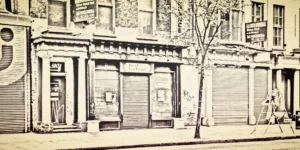Nail salons, 3d printing shops and charity shops; no this isn’t Swindon, this is your high street circa 2030. ParcelHero’s report investigates what the next 13 years has in store for the UK’s high streets. Along with the high-profile names we have lost in recent years, it is predicted that many more household names will disappear in the coming years.
Intrinsic to the reshaping of our highstreets is the unstoppable rise of e-commerce. the fastest growing online retailer – Amazon; accounted for 10% of the total retail sales growth, on and offline, over the first six months of 2016. With its online revenue at nearly £4.5m, Amazon are now sitting very comfortably at the top of the food chain.
In May 1984, Gateshead (a town in Tyne & Wear, England) was the location of the world’s first recorded online home shopper. A 72-year old grandmother named Mrs Jane Snowball, purchased groceries from her local Tesco store in the world’s first ever online shopping transaction from the home.
As the following chart shows, online shopping is now a staple revenue maker for many of the big names in UK commerce:

Graham Ruddick, formerly the Telegraph’s Retail Correspondent and now Senior Business Reporter at The Guardian, – ’The potential repercussions of Amazon Prime Now – enabling shoppers in London to receive orders within an hour – are that it destroys everything we understand about the differences between online and high street shopping.
‘We have been told that the strength of physical high street shops and supermarkets is that they are convenient. If you need a product urgently, then you still have to go to a shop, because an online order may not arrive until the next day, at best. But if Amazon can deliver products in an hour, to a destination of your choice, then suddenly the internet becomes the most convenient form of shopping.’
Home deliveries, or drop offs to handy collection points and lockers, will spell the end for many famous names on town centre shop fronts.
Innovation is something which will be heavily invested in within the coming decade. Amazon Dash is a great example of this. With the simple push of a button – or even by speaking to the gizmo for some versions – Dash re-orders consumers washing powder, coffee or one of 40 products at launch (and escalating very rapidly). With further connectivity promised, it seems that automated ordering could go hand in hand with automated delivery.
Autonomous vehicles and droids will likely be delivering into retail outlets and direct to town centre homes from these out of town distribution centres. And the capability will be in place to deliver by drones – though security fears may continue to block their adoption in major cities.
Specialist vehicles will become far more important, with shopping becoming a more social experience again. Local food deliveries will increase: with Uber-style crowd source Apps that will deliver orders inexpensively toy your door.
By 2030 e-commerce will account for around 40% of all UK retail sales. Read ParcelHero’s full report to find out exactly why the next 13 years will change our city centres so dramatically.








